Do-it-yourself gas boiler heat exchanger repair + instructions on repair and replacement of parts
Agree, you do not always monitor the boiler and try to check it as rarely as possible.At the same time, you may like to repair household appliances yourself, and not necessarily for the sake of saving money. If you have been using boilers for a long time, then you know about the peculiarities of their heat exchangers, as parts that often cause breakdowns. If you want to repair the gas boiler heat exchanger yourself, read our instructions and make sure that it is not at all difficult.
From our article you will learn how to remove the primary and secondary heat exchangers from the boiler. In addition, you will learn how to care for and repair these parts. If you are not familiar with the structure of the boiler, then, among other things, you will understand the structure of the exchangers, learn about their location, and the principle of operation.
A lot of water passes through the heat exchangers of boilers; over time, they become clogged and sometimes become deformed. In this article we have provided important information about their cleaning, repair and replacement. We'll cover enough about heat exchangers so that you can repair these boiler parts on your own.
The content of the article:
Primary heat exchanger of a gas boiler
The primary, or simply heat exchanger, is a large pipe-like piece with bends through which thin plates pass. This shape and the device itself are also called a coil.
Manufacturers make heat exchangers from stainless metals such as copper and stainless steel. For different brands of boilers, they hardly differ in structure - shell-and-tube in the form of a coil.
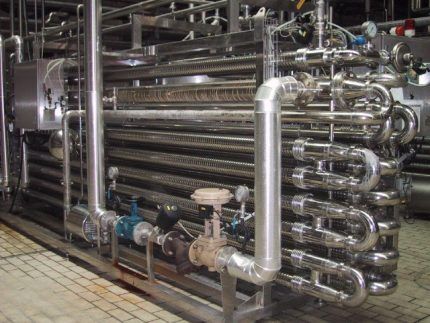
The device transfers thermal energy from gas to a coolant - usually water. The units differ in power, and the greater the length of the pipe and the number of ribs (bends), the higher it is. The heat exchanger works well as long as soot outside and salts inside do not accumulate in excess. Then circulation is disrupted and the thermal conductivity of the walls decreases. Heat exchangers should be cleaned on time and protected with water filters.
In the boiler design, the primary exchanger is located in the combustion chamber, above the main burner flame. The manufacturing material with high heat transfer retains heat well and loses it quickly enough, as necessary. Thanks to the narrow plates, thermal energy is distributed more evenly. The primary heat exchanger is the main heating element of a gas boiler, excluding the burner.
Primary heat exchanger repair
The exchanger deteriorates due to poor quality coolant or the materials from which it is made, as well as other factors. Pressure, high temperatures and their differences lead to cracks, which is why the element begins to work less powerfully and breaks down over time. The life of the heat exchanger can be extended if purified water is supplied and the boiler is not overloaded.
It will be more difficult to eliminate cracks than clogs. The heat exchanger is soldered for this purpose. Select solder from the same material as the unit itself. Boiler heat exchangers are usually made of copper, less often cast iron or steel. Aluminum, silicon, manganese, nickel and zinc are added to the composition.
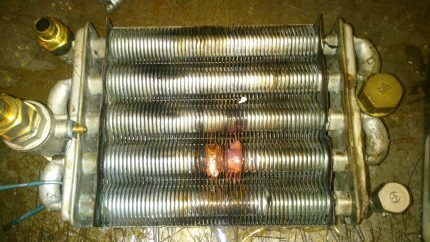
Additional solder requirements:
- melting point not lower than 700 °C;
- sufficient viscosity;
- fluidity is the same as that of a heat exchanger.
Copper-zinc solders are considered one of the best. They are used for soldering most non-ferrous metals with a higher melting point than the support material itself. Solders with inclusions of silicon or tin - up to half a percent - are safer for the human body.
It is better to avoid copper-phosphorus materials, and if exchangers are soldered with them, do so without any load such as shock or vibration. Well-chosen solder is half the battle.
Heat exchangers are soldered with gas burners and blowtorches. Before soldering, the desired area is cleaned with fine-grained sandpaper and wiped with a rag with a solvent, and then heated. The area is heated with a hairdryer or a weak burner/soldering iron. At this moment, the main thing is to get into the temperature corridor and take into account subsequent cooling. Barely noticeable damage is found by small greenish spots.
Before heating, the water is drained, and its remains are removed with a compressor or blown out through a flexible hose. The hose is fixed by thread if it has a union nut and the design features allow this. If you leave water, it will take away part of the thermal energy.
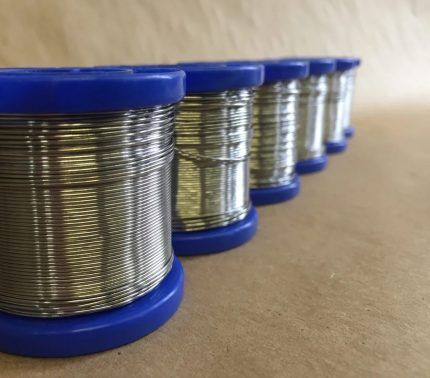
Solder is preferred in the form of a wire or rod: when soldering, the molten end will be well immersed in the flux, which will stick to it. If the wire lays on the exchanger itself too intermittently or loosely, the preheating was weak. After work, the soldering area is sometimes coated with heat-resistant paint for better insulation.
Over the next two weeks, the soldered area is checked daily for integrity. At the first detected leak, you should contact a specialist. If it appears in the first fortnight, it means the soldering was of poor quality.
The flux is suitable for universal use, as well as gel soldering flux. Avoid rosin, unusual options like aspirin and others.
Cleaning the primary heat exchanger
Buy a solution for washing heat exchangers - it removes even severe contamination. Use special brushes and scrapers to manually clean accessible areas inside and outside the exchanger. Remove the soot.
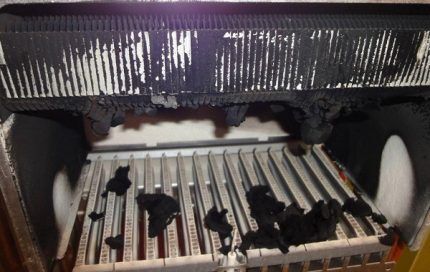
In a difficult situation, order a chemical flush. The masters will clean the exchanger through a booster, to which they will add acid - sulfamic acid, for example. After special treatment, no old and persistent deposits will remain. Or you can wash the heat exchanger yourself. To do this, we suggest using with the following instructions.
Cleaning is possible without disassembly - with hydrodynamic flushing. Small particles under high pressure will remove any contamination.
Replacing an old or broken heat exchanger
To remove the exchanger for flushing or replacement, first of all, you need to disconnect the boiler from the gas supply and the electrical network.Then remove the front panel of the boiler and block the supply and return heating pipes. The coolant is drained through the drain valve on the boiler.
Further actions require greater precision and concentration of effort:
- We remove the fastenings on the tube supplying gas to the combustion chamber. Disconnect this pipe.
- We free the combustion compartment cover from suitable communications: we move the ignition and control electrodes to the side.
- We remove the sensors from the combustion chamber. We unscrew the fasteners on its cover and remove the latter.
- Disconnect and take out the fan.
- We remove the clamps from the pipes approaching the primary heat exchanger. Let's remove these tubes.
- We detach the combustion chamber from the boiler wall and move it outside.
- Unscrew the hardware of the top cover of the combustion compartment. Remove the top.
- We remove the fasteners that hold the primary heat exchanger and take it out.
Now we can replace the faulty exchanger with a new one. We fix it in the combustion chamber, separate from the boiler. We fix it around the perimeter with hardware and return the top cover to its place.

We attach the combustion compartment back to the inner wall of the boiler. We attach the front cover. We return all disconnected parts and removed components near the combustion chamber to their place.
Look at what the seals look like inside the gas boiler and change them at the necessary connections before installing the heat exchanger. After complete assembly, prepare the boiler for operation and do a test run.
Secondary heat exchanger of a gas boiler
It is also called a hot water supply (DHW) heat exchanger.This is a rectangular device with interconnected internal plates made of food grade stainless steel. The more there are, the higher the performance of the unit. Inside they form from 8 to 30 layers. The high thermal conductivity of the materials and the large interaction area provide the necessary heat exchange with fast water movement.
Each layer is a channel isolated within the heat exchanger. The plates have a relief from which these passages are formed. The thickness of the partitions is usually 1 mm. The channels have angles, and the sharper they are, the higher the fluid speed and vice versa. The pattern of water movement can be single- or multi-pass - with a change in direction. In the second case, higher efficiency is achieved.
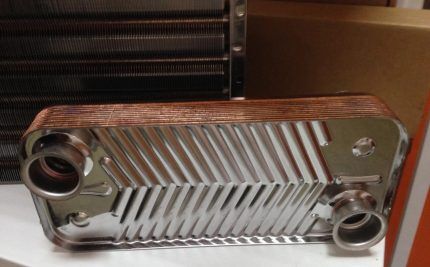
After opening the hot water valve on the mixer three-way the valve directs part of the heated coolant to the secondary exchanger. Next, the hot liquid transfers heat to the cold tap water in the unit, after which heated water comes out of the heat exchanger to be supplied through faucets in the kitchen and bathroom.
The cooled coolant then exits into the pipe, where it is mixed with the return fluid - waste coolant from the heating system, and again enters the primary exchanger.
The secondary heat exchanger is usually located below the combustion chamber. In different boilers it is mounted vertically or horizontally on its side.
Boilers also use combined heat exchangers - bithermal. In them, communication with hot water is surrounded by channels with coolant for the heating system. First, the gas transfers energy to the coolant, and then the latter directs part of it to the hot water supply.Since gas boilers with such heat exchangers are simpler, a three-way valve is not needed.
Repair of secondary heat exchanger
Secondary heaters often clog, especially models with narrow channels. Without cleaning, they break down over time and finally fail. A layer of scale inside the unit reduces heat transfer, causing the boiler to consume more gas.
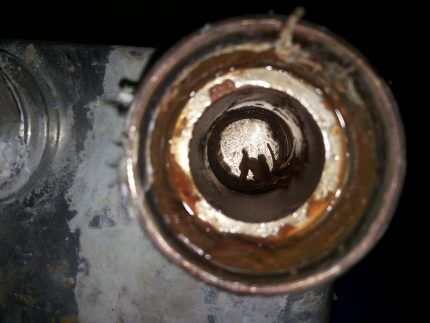
Problems with heat exchangers will be indicated by codes on the boiler display. There is an action plan for this case.
Let's take a closer look at the problem with the secondary heater:
- We take out the secondary heat exchanger.
- We look at the joints, internal and external threads. After the last cleaning, their condition may have worsened. This happens due to aggressive acids. We replace worn out removable elements.
- We check the integrity. Could happen to the heat exchanger water hammer. Only a specialist will find a very small fistula (hole).
- We better inspect the exchanger, and for this we call a specialist. We replace a severely damaged unit.
- Even at the very beginning, contamination can be found. We look for plaque visually in the inlet openings. We blow air into the part and also focus on the sound. We clean it if the exchanger is clogged. Pieces of scale may fall out of it even after a slight knock.
- You need to choose 1 of 3 cleaning options: home remedies like detergents and solutions with citric acid, special mixtures, or professional cleaning.
First of all, rinse the exchanger with a stream of water from a cold tap. Then pour citric acid into the device and place it in a bucket of water.Afterwards, take out the heat exchanger and pour water into it to check the permeability.
If it comes in slowly or does not move, then prepare a saturated solution of vinegar in water and pour it there. Then rinse with hot water and blow off. If possible, use an air pump. Do several cycles with vinegar.
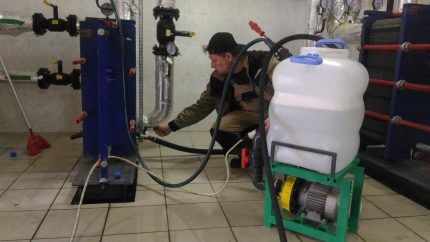
If the steps described do not help, try special cleaning solutions: cleaning gel or low-percentage adipic acid solution. If this method does not work, then call a specialist or order professional cleaning.
How to replace a part?
No special knowledge is needed for this. To remove the old exchanger for inspection or replacement, follow these steps:
- Turn off the power supply and turn off the gas.
- Remove the front boiler cover.
- Shut off the cold water supply to the DHW circuit. Close the valves on the flow and return pipes of the heating circuit.
- Remove the plug from the drain hole. Drain all water from the boiler.
- Reduce the pressure in the system if necessary and remove air.
- Pull out the electronic board. To do this, remove the necessary fasteners.
- Remove the terminals from the gas valve.
- Remove the boiler elements that prevent easy removal of the secondary heat exchanger: cold water supply inlet pipe, water fittings, etc. Remove the corresponding brackets, nuts and clamps.
- Insulate all electrical components and wires with waterproof material.
- Unscrew the fasteners holding the secondary heat exchanger. Use a convenient tool.Sometimes this can be done with a hexagon. Manufacturers try to place the exchanger in a convenient place so that the boiler elements do not suffer during its removal.
- Remove the secondary heat exchanger and remove water from it.
At the time of removal, it is worth remembering the location of the exchanger in order to install it back in the same way or install a new one.
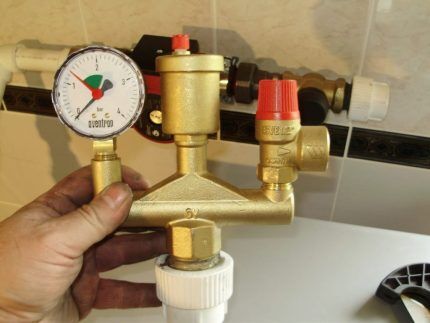
Apply copper grease to the connections that secure the unit inside the boiler. This will protect it from oxidation.
Also, replace worn seals before returning the part to its place.
Conclusions and useful video on the topic
How to remove the heat exchanger from the Baxi boiler, how to clean it:
Cleaning the primary exchanger using reagents, overview of the products and the final result:
Idea for repairing a broken primary heat exchanger inlet:
We talked about two types of heat exchangers. The primary one is above the burner of the combustion chamber and the secondary one is for heating running water. Now you have a better understanding of the design of gas boilers and understand the importance of heat exchangers in their operation. We also presented two partially similar algorithms for replacing exchangers.
If necessary, you can start soldering this part. You will be able to wash at home. Do not forget also about the quality of materials if you still have to buy a new part.
Leave comments and ask questions. Tell us about your boiler. Write how many heat exchangers it has. Did you change them, and how long did the old exchangers last? Write about it in the contact form located under the article.




Thank you for the article! I have a Beretta ciao 24 cai boiler, the heat exchanger leaked after 3-98-4 years of operation. The heat exchanger is bithermic, copper. The top is covered with another silver-colored metal.
I have a question for you, what kind of solder should I use to solder this copper heat exchanger? There is a gas burner for soldering; there is also tin-lead solder.
I watched a video on your website about repairing a heat exchanger, lead-tin solder will not work, it will fall off.
Is copper-zinc solder PMC-36 or PMC-39 suitable for high-quality soldering of a copper heat exchanger?
Thank you.
We have a Navien boiler, the master said that we need to change the heat exchanger, it is very clogged, some time ago, they changed the combustion chamber, then the temperature and overheating sensors went off, at first he said that it was due to voltage drops, then, like, because of the heat exchangers, help, I want to figure it out, Every year we do maintenance and the master was silent about the heat exchangers
Need an ultrasonic bath! You can't break through inside like that!